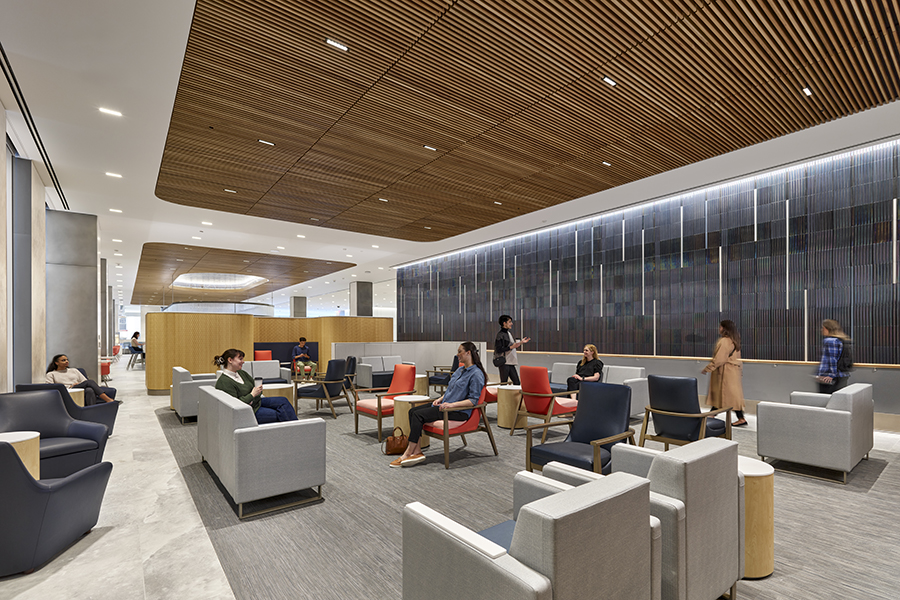How this New, Innovative Philly High-Rise Could Reshape the Healthcare Experience

Courtesy of Ennead Architects
Seeking medical help is a fundamental part of our lives, and, especially for anyone with a recurring medical condition, your chosen healthcare facility can become a familiar place. It makes sense, then, that healthcare systems invest in that facility, to try to create as positive and impactful an experience as possible. And that’s what Jefferson Health is creating with its newly opened Honickman Center.
“We absolutely believe that this is a model for the next generation of healthcare, no question,” says Dr. Edmund deAzevedo Pribitkin, Chief Physician Executive at Jefferson Health.
The 19-story high-rise is not just a major addition to the Philadelphia skyline, but an outpatient center that brings together Jefferson’s specialty care services in one place. What makes the facility transformative is that the Center was consciously designed to maximize both comfort and convenience by a team of physicians, designers and accessibility advocates and patients. From cutting-edge technology to patient-centered design to communal areas open to the public, the Center is a new kind of healthcare space–one that actively supports the patient’s care.
To get an inside look into how the building could set a new standard for healthcare going forward, we spoke to the people behind the Honickman Center’s design.

Easy Access
Patients can access the core of Jefferson Health’s outpatient services at the Honickman Center at the heart of Center City (it’s at 1101 Chestnut Street). That was the main impetus behind the structure, to help patients get the care they need without having to move back and forth across Philadelphia. Accordingly, one of the design’s key focuses is convenience.
The benefits of that approach begin before you even enter the building. For one, there’s parking underneath the Honickman Center, so patients can expect to dodge the frustrations of the meter. And the building itself is a great place to wait to see the doctor. Instead of sitting with your phone in the waiting room, you can explore artwork in the cafe and sky deck areas prior to your appointment.

Patient-Centered Design
That attention to the patient experience continues when you enter the building. The first thing you notice may be the high ceilings. The building is unusually tall for a 19-story building, and that’s because of the ceiling height, meant to give a sense of spaciousness and calm that can help counteract any anxiety about a medical appointment. The height also helps maximize light, thanks to large windows and an intentional placement of patient spaces near sunlight.
The focus on the patient’s experience goes even deeper–local Philadelphia art meets you on most floors, in part to bring Philadelphia’s culture and spirit into the building, but also to help promote an environment of healing. Wood materials are featured throughout the rooms and their decor, not just for a more natural feel, but also because of its sound-dampening properties, which can create a greater sense of peacefulness.
“The goal really is to bring people into a total healing experience,” Dr. Pribitkin says.
That insight is one of many that the designers of the building gathered from conversations with disability and neurodiversity advocates.
“We think this could be the beginning of a new design process, where it’s not just going to be an architect who designs the whole thing, but they’re going to work hand in glove at every step with marginalized people and with disabled people,” says Matthew Purinton, clinical social worker and member of the Jefferson Patient and Family Advisory Council for the project.
Throughout, the Center incorporates design features that make the building as accessible as possible. Ambassadors have been carefully trained to guide and support people in their navigation of the building. Desks are designed specifically for ease of use while using a wheelchair. Chairs and walls are designed with neurodiversity in mind, incorporating textures that are calming to touch. The building even incorporates a relief area for service dogs, and nature-scapes located on each floor feature organic designs and a place to de-stress.
“We really wanted the Honickman Center to be a place where everyone felt like they belonged,” Mr. Purinton says. “We wanted to create the ambulatory care building that some people have been waiting for their whole life. And we believe that’s what we did.”

Advancing Care
For those with a recurring or chronic medical condition, this creates an environment that feels like it’s designed for the fact that they’re going to spend a significant amount of time there.
Throughout the building, care is also supported through technological advancements. Specially designed modular walls allow for quick construction and deconstruction of spaces according to the physician’s need, and the building gets more futuristic from there. Patient spaces include digital whiteboards for physician and patient use. These are convenient for sketching out a concept, but perhaps more importantly, they allow other family members or even other physicians to teleconference in through a video call, to listen in or provide additional insight.
A key aspect of the building is creating a seamless experience–to make it easier on the patient, and to ensure they don’t have to spend longer in a healthcare facility than necessary. To that end, special exam chairs take patient’s key information as soon as they sit in them, so they can skip the scale entirely. The exam rooms are also outfitted with recording technology, so that the physician can interact directly with the patient, rather than taking notes on a clipboard. These recordings can also be easily reviewed by other physicians and used for training later on.
“We want you to have a direct connection to the caregiver,” says Dr. Catriona Harrop, Associate Chief Physician Executive at Jefferson Health.
The overall effect of the building is an improved patient journey from start to finish, where checking in, meeting with the doctor, and receiving care feels as natural and smooth as possible. That experience could well set a new standard for how we think about healthcare’s everyday function, and it’s something that Jefferson is choosing to share with the community. Thanks to a rooftop deck with wellness programming, and spaces set aside for lectures and talks, the building promises to become a key part of Philadelphia not just for patients, but for residents as a whole.
“Part and parcel,” Dr. Harrop says, “this building represents Jefferson’s commitment to our communities that we serve.”
This is a paid partnership between Jefferson Health and Philadelphia Magazine

